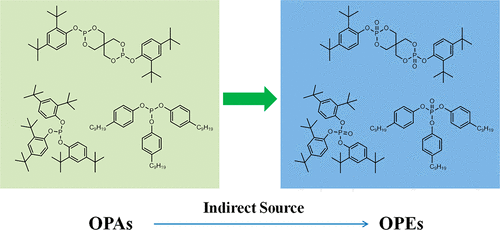当前位置:
X-MOL 学术
›
Environ. Sci. Technol.
›
论文详情
Our official English website, www.x-mol.net, welcomes your
feedback! (Note: you will need to create a separate account there.)
Organophosphite Antioxidants in Indoor Dust Represent an Indirect Source of Organophosphate Esters
Environmental Science & Technology ( IF 10.8 ) Pub Date : 2019-02-04 , DOI: 10.1021/acs.est.8b05545 Runzeng Liu 1 , Scott A. Mabury 1
Environmental Science & Technology ( IF 10.8 ) Pub Date : 2019-02-04 , DOI: 10.1021/acs.est.8b05545 Runzeng Liu 1 , Scott A. Mabury 1
Affiliation

|
Precise determination of organophosphate esters (OPEs) in the environment is crucial to estimating their potential toxicity effects on human health. Previous studies have mainly focused on OPEs from direct sources. This study explored a potential indirect source of OPEs: the oxidation of organophosphite antioxidants (OPAs). OPAs are frequently used to retard degradation in polymers through their oxidation to OPEs. In this work, five OPAs [tris(2-chloroethyl) phosphite, triphenyl phosphite, tris(2,4-di-tert-butylphenyl) phosphite, bis(2,4-di-tert-butylphenyl) pentaerythritol diphosphite, and trisnonylphenol phosphite] could be identified, with geometric mean (GM) concentrations from 2.46 to 70.4 ng/g, in indoor dust. Their oxidation products, triisodecyl phosphate (TiDeP), tris(2,4-di-tert-butylphenyl) phosphate (AO168═O), bis(2,4-di-tert-butylphenyl) pentaerythritol diphosphate (AO626═O2), and trisnonylphenol phosphate (TNPP), were found at significantly higher GM concentrations (30.5–3759 ng/g). Surprisingly, two novel oxidation products AO168═O (GM: 3759 ng/g) and TNPP (GM: 2185 ng/g) had higher concentrations than tris(2-chloroethyl) phosphate (GM: 1608 ng/g) and triphenyl phosphate (GM: 1827 ng/g), which are well-known OPEs. These four novel OPEs (TiDeP, TNPP, AO168═O, AO626═O2) contributed 54.1% to the total concentration of the eight OPEs. The present investigation demonstrates that oxidation of OPAs is an important indirect source of novel OPEs in indoor environments. This is the first detection of four OPAs and their newly identified OPE oxidation products in indoor dust.
中文翻译:

室内粉尘中的有机亚磷酸酯抗氧化剂代表有机磷酸酯的间接来源
精确测定环境中的有机磷酸酯(OPE)对于评估其对人体健康的潜在毒性影响至关重要。先前的研究主要集中在直接来源的OPE。这项研究探索了潜在的OPE间接来源:有机亚磷酸酯抗氧化剂(OPA)的氧化。OPA通常用于通过氧化为OPE来阻止聚合物降解。在这项工作中,五种OPA [亚磷酸三(2-氯乙基)酯,亚磷酸三苯酯,亚磷酸三(2,4-二叔丁基苯基)酯,季戊四醇双亚磷酸二(2,4-二叔丁基苯基)酯和亚磷酸三壬基酚酯可以被鉴定出来,室内尘埃的几何平均(GM)浓度为2.46至70.4 ng / g。它们的氧化产物磷酸三异癸酯(TiDeP),三(2,4-二-叔丁基苯基)磷酸酯(AO168═O),双(2,4-二-叔丁基苯基)季戊四醇二磷酸酯(AO626═O 2),和trisnonylphenol磷酸盐(TNPP),物在显著更高GM浓度实测值(30.5-3759 ng / g)。令人惊讶的是,两种新型氧化产物AO168═O(GM:3759 ng / g)和TNPP(GM:2185 ng / g)的浓度高于磷酸三(2-氯乙基)磷酸酯(GM:1608 ng / g)和磷酸三苯酯(GM GM:1827 ng / g),这是众所周知的OPE。这四个新的OPE(TiDeP,TNPP,AO168═O,AO626═O 2)对八个OPE的总浓度贡献了54.1%。本研究表明,OPAs的氧化是室内环境中新型OPE的重要间接来源。这是首次检测到室内粉尘中的四种OPA及其新发现的OPE氧化产物。
更新日期:2019-02-06
中文翻译:

室内粉尘中的有机亚磷酸酯抗氧化剂代表有机磷酸酯的间接来源
精确测定环境中的有机磷酸酯(OPE)对于评估其对人体健康的潜在毒性影响至关重要。先前的研究主要集中在直接来源的OPE。这项研究探索了潜在的OPE间接来源:有机亚磷酸酯抗氧化剂(OPA)的氧化。OPA通常用于通过氧化为OPE来阻止聚合物降解。在这项工作中,五种OPA [亚磷酸三(2-氯乙基)酯,亚磷酸三苯酯,亚磷酸三(2,4-二叔丁基苯基)酯,季戊四醇双亚磷酸二(2,4-二叔丁基苯基)酯和亚磷酸三壬基酚酯可以被鉴定出来,室内尘埃的几何平均(GM)浓度为2.46至70.4 ng / g。它们的氧化产物磷酸三异癸酯(TiDeP),三(2,4-二-叔丁基苯基)磷酸酯(AO168═O),双(2,4-二-叔丁基苯基)季戊四醇二磷酸酯(AO626═O 2),和trisnonylphenol磷酸盐(TNPP),物在显著更高GM浓度实测值(30.5-3759 ng / g)。令人惊讶的是,两种新型氧化产物AO168═O(GM:3759 ng / g)和TNPP(GM:2185 ng / g)的浓度高于磷酸三(2-氯乙基)磷酸酯(GM:1608 ng / g)和磷酸三苯酯(GM GM:1827 ng / g),这是众所周知的OPE。这四个新的OPE(TiDeP,TNPP,AO168═O,AO626═O 2)对八个OPE的总浓度贡献了54.1%。本研究表明,OPAs的氧化是室内环境中新型OPE的重要间接来源。这是首次检测到室内粉尘中的四种OPA及其新发现的OPE氧化产物。


















































 京公网安备 11010802027423号
京公网安备 11010802027423号